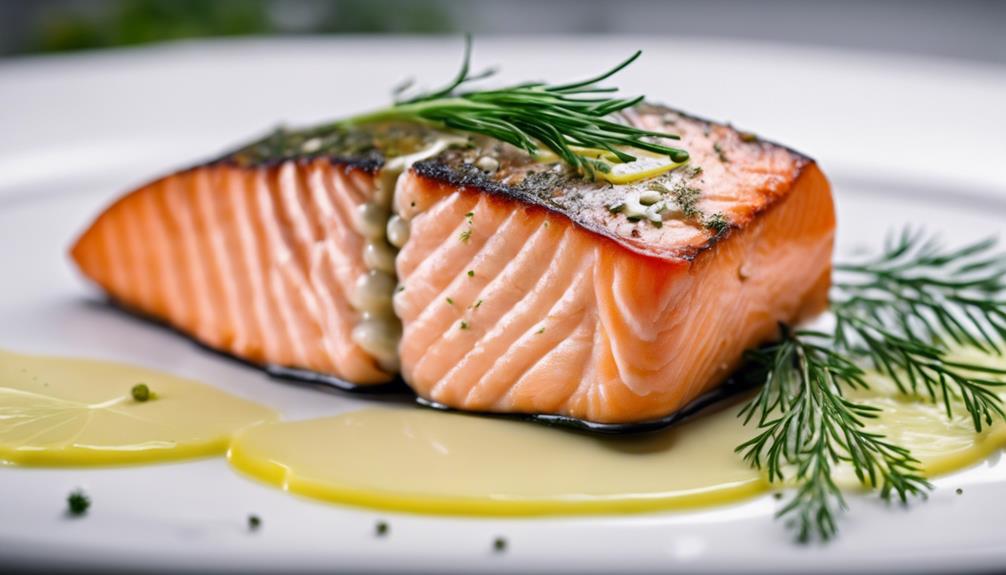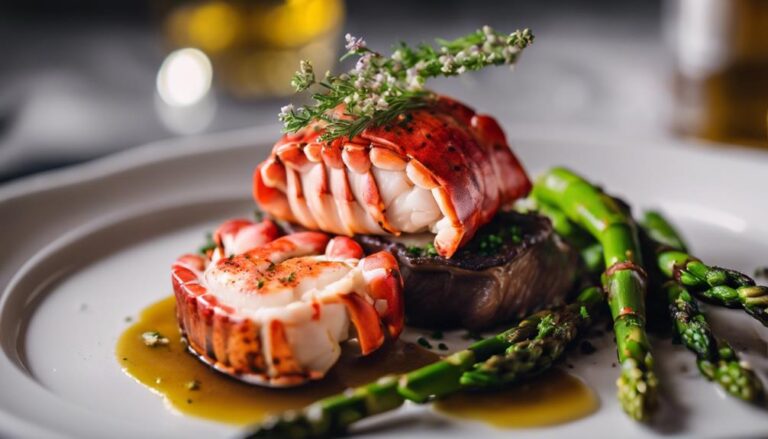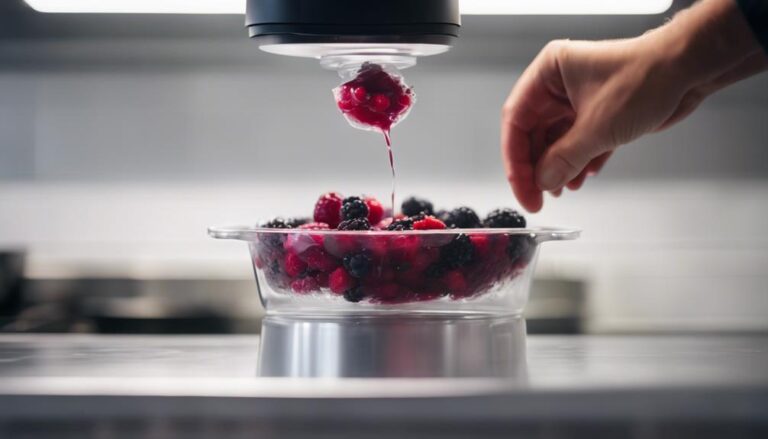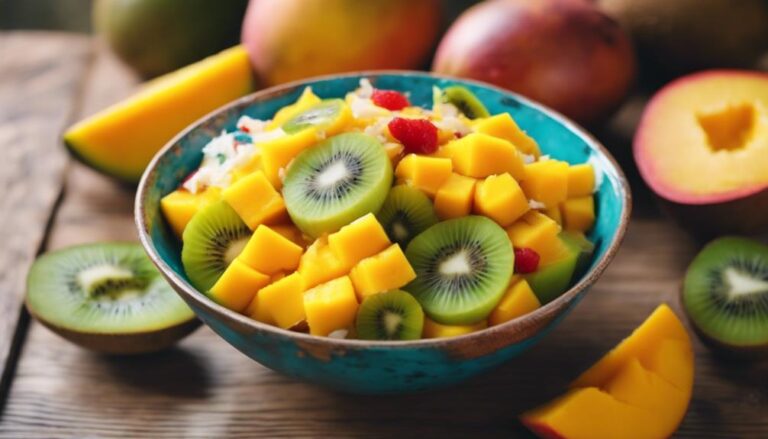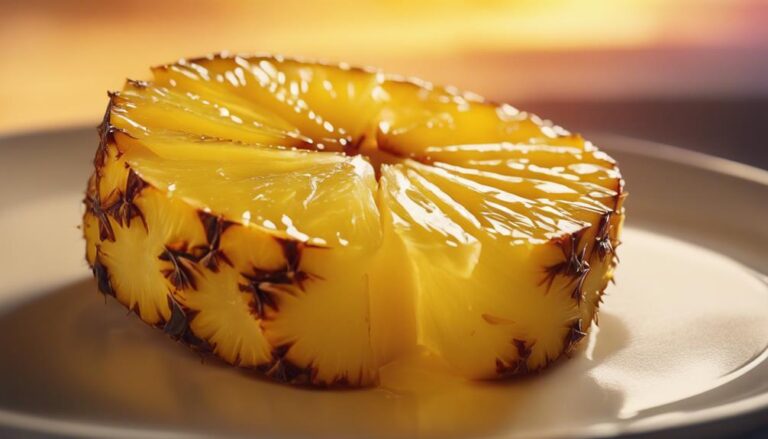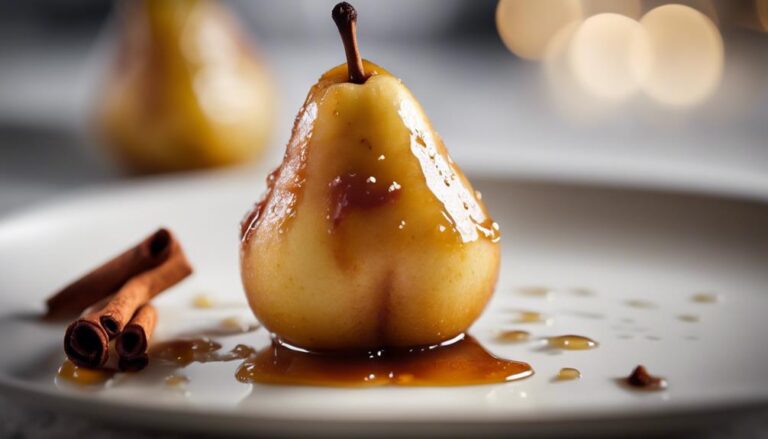Sous Vide Salmon With Dill
To prepare sous vide salmon with dill, set your water bath between 110°F to 130°F for desired tenderness. Lower temps mean a tender texture, while higher ones offer firmness. Let it cook at 125-130°F for 30 mins to 1 hour for flakier fish. Key ingredients like dill, lemon zest, and garlic enhance flavor. This method retains moisture and tenderness, showcasing quality ingredients. The slow precision of sous vide cooking guarantees a restaurant-quality dish at home, elevating the succulent taste of salmon with the subtle herbaceous note of dill. Master this technique for a delectable salmon experience.
What You Will Learn Here
- Dill enhances salmon's delicate flavor profile in sous vide cooking.
- Sous vide method ensures precise cooking for tender and moist salmon.
- Temperature control crucial; 125-130°F for flaky texture in 30-60 minutes.
- Quality ingredients and sous vide technique create restaurant-quality salmon.
- Nordic culinary influence on salmon preparation highlights simplicity and natural flavors.
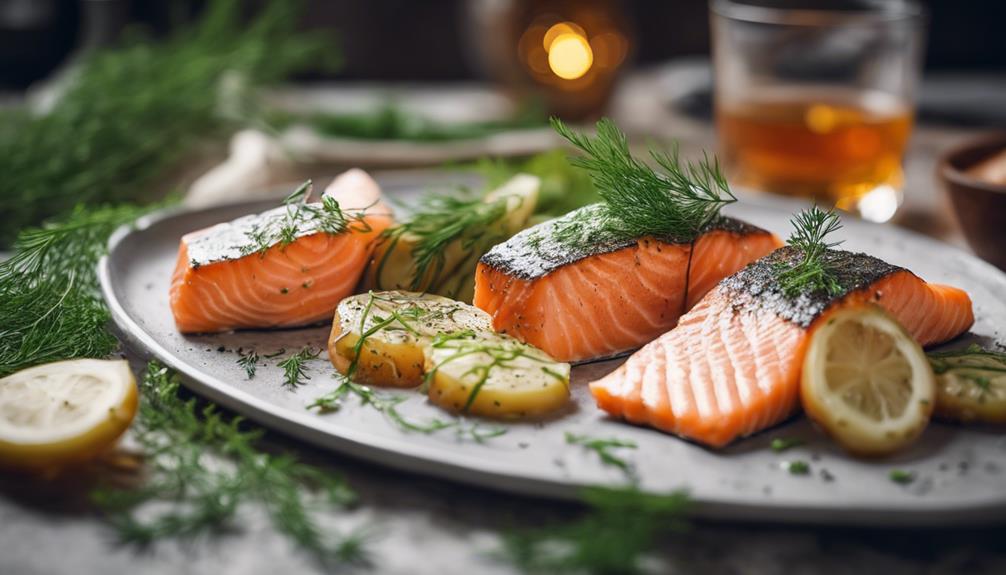
Salmon's Scandinavian culinary roots are deeply tied to Nordic traditions, where the fish holds a prominent place on the dining table.
Dill, a herb commonly used in Scandinavian cuisine, imparts a distinctive flavor to salmon dishes, enhancing its taste.
The culinary influences on salmon in this region have shaped the way it's prepared and enjoyed worldwide.
Nordic Salmon Traditions
Nordic culinary heritage intertwines with the rich history of salmon preparation, showcasing a fusion of traditional techniques and modern innovation. In Scandinavian countries like Norway, Sweden, and Denmark, salmon holds a revered place in traditional cuisine, reflecting the region's deep connection to the sea. The preparation of salmon in Nordic traditions often involves methods like smoking, curing, and gravlax, where the fish is marinated in a mixture of salt, sugar, and dill.
Salmon has been a staple food source in Nordic regions for centuries, with techniques passed down through generations. In countries like Norway, which boasts a long coastline teeming with salmon-rich waters, the fish has become synonymous with culinary excellence. In Sweden, gravlax, a dish where salmon is cured with a blend of salt, sugar, and dill, showcases the simplicity and elegance of Nordic flavors. These traditional methods of preparing salmon highlight the region's respect for quality ingredients and culinary craftsmanship.
Dill plays an essential role in traditional Scandinavian cuisine, adding a unique flavor profile to various dishes. In Scandinavian countries like Sweden, Norway, and Denmark, dill is a popular herb used in both cooking and garnishing. Its fresh, slightly sweet, and tangy taste complements the region's culinary staples, such as salmon, herring, and potatoes. Scandinavian cuisine is known for its emphasis on fresh, natural ingredients, and dill fits perfectly into this culinary philosophy.
In Scandinavian cooking, dill is often paired with seafood, particularly salmon. The herb's bright and aromatic notes enhance the delicate flavor of salmon, creating a harmonious combination that has become a signature of Nordic cuisine. Whether used in gravlax, a traditional Scandinavian cured salmon dish, or as a seasoning for grilled salmon fillets, dill adds an invigorating touch that elevates the overall taste of the dish.
Culinary Influences on Salmon
With its deep-rooted presence in Scandinavian cuisine, salmon has absorbed a multitude of culinary influences that have shaped its flavor profile over the years. In Scandinavian culinary traditions, salmon holds a position of high esteem, often being prepared in various ways that highlight its natural flavors. The cold waters of the region provide an ideal environment for salmon to thrive, leading to its widespread use in Nordic dishes.
One of the most iconic Scandinavian methods of preparing salmon is gravlax, where the fish is cured with a mixture of salt, sugar, and dill. This process not only preserves the salmon but also imparts a delicate balance of flavors that have become synonymous with Nordic cuisine. Additionally, smoking salmon is another prevalent technique in the region, adding a rich and smoky dimension to the fish.
Scandinavian culinary influences on salmon emphasize simplicity and respect for the natural ingredients, allowing the fish's inherent taste to shine through. These traditions have greatly contributed to the popularity of salmon dishes worldwide, showcasing the culinary artistry rooted in the Scandinavian region.
Key Ingredients for Flavor
For enhancing the taste of your sous vide salmon, consider incorporating a blend of aromatic herbs and citrus zest. Here are three key ingredients that can elevate the flavor profile of your dish:
- Dill: Known for its fresh and slightly tangy flavor, dill is a classic herb that pairs exceptionally well with salmon. Its vibrant, herbaceous notes can bring a revitalizing element to your sous vide salmon, enhancing its overall taste and aroma.
- Lemon Zest: The zest of a lemon contains essential oils that carry a burst of citrusy flavor without the acidity of the juice. Adding lemon zest to your sous vide salmon can provide a zesty brightness that complements the richness of the fish, creating a harmonious balance of flavors.
- Garlic: A staple in many savory dishes, garlic can add depth and complexity to your sous vide salmon. Whether minced or thinly sliced, garlic infuses a savory umami flavor that can intensify the taste of the fish while adding a subtle aromatic essence to the dish.
Tried-and-True Salmon Dishes
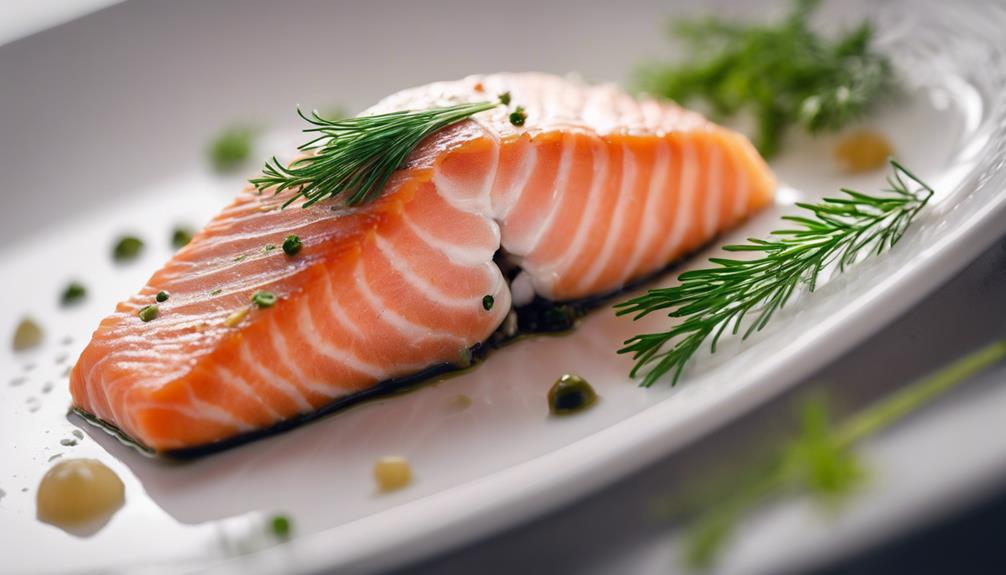
When it comes to salmon, you can never go wrong with classic dishes like Sous Vide Salmon Delight, Dill-Infused Salmon Delight, and Savory Herb-Crusted Salmon.
These tried-and-true recipes are sure to impress with their delicious flavors and simple preparation methods.
Whether you're a seasoned cook or just starting out, these salmon dishes are a great way to elevate your culinary skills and delight your taste buds.
Sous Vide Salmon Delight
Indulge in a flavorful culinary experience with this tried-and-true sous vide salmon delight. The sous vide cooking method guarantees that the salmon is perfectly cooked to a tender and moist finish, sealing in all the delicious flavors. Here are three reasons why this sous vide salmon dish is a must-try:
- Perfectly Cooked: Sous vide cooking allows the salmon to cook gently and evenly in its juices, resulting in a perfectly cooked piece of fish every time. Say goodbye to overcooked or undercooked salmon!
- Enhanced Flavor: By cooking the salmon in a vacuum-sealed bag, the flavors intensify, and the fish absorbs all the delicious seasonings and aromatics you add. Each bite bursts with a rich and savory taste.
- Consistent Results: With sous vide cooking, you can achieve consistent results every time you prepare this salmon delight. Say hello to a foolproof way of cooking salmon that impresses every palate.
Try out this sous vide salmon recipe and elevate your culinary skills to new heights!
Dill-Infused Salmon Delight
Delight your taste buds with a dill-infused salmon dish that promises to elevate your dining experience. This flavorful combination of salmon and dill will leave you craving more. Here are three reasons why this dill-infused salmon delight stands out:
- Freshness: The aromatic dill complements the tender salmon, creating a burst of freshness with every bite.
- Flavor Fusion: The subtle earthiness of dill merges perfectly with the rich taste of salmon, offering a harmonious blend of flavors that dance on your palate.
- Nutritional Benefits: Not only is this dish a treat for your taste buds, but it also packs a punch when it comes to health benefits. Salmon is rich in omega-3 fatty acids, while dill is loaded with vitamins and antioxidants, making this dish a nutritious choice.
Whether you're a seafood enthusiast or looking to try something new, this dill-infused salmon dish is a must-try for anyone seeking a delightful culinary experience.
Savory Herb-Crusted Salmon
Sink your teeth into the savory herb-crusted salmon, a classic dish that never fails to impress with its robust flavors and satisfying crunch. This tried-and-true recipe combines the delicate taste of salmon with a crispy herb crust that elevates the dish to a whole new level. Here's why you'll love this savory herb-crusted salmon:
- Flavor Explosion: The blend of fresh herbs like dill, parsley, and thyme creates a burst of flavor with every bite, complementing the richness of the salmon perfectly.
- Crunchy Texture: The crispy crust adds a delightful texture contrast to the tender salmon, providing a satisfying crunch that keeps you coming back for more.
- Simple Preparation: With just a few basic ingredients and easy steps, you can whip up this impressive dish in no time, making it ideal for a quick weeknight dinner or a special occasion.
Whether you're a seafood lover or just looking to try something new, this herb-crusted salmon is sure to become a favorite in your recipe repertoire.
Sous Vide Time Recommendations
When cooking sous vide salmon, the KEY ASPECTS to keep in mind are ideal cooking temperatures, timing, and achieving your desired texture.
It's important to follow recommended time guidelines to make sure your salmon is cooked perfectly.
Optimal Cooking Temperatures
Discussing ideal cooking temperatures in sous vide requires precise control over the water temperature to achieve desired results. For salmon, the best cooking temperature typically ranges between 110°F to 130°F (43°C to 54°C). At 110°F (43°C), the salmon will be incredibly tender and almost raw, providing a unique texture. As you increase the temperature towards 130°F (54°C), the fish becomes firmer and more opaque, resembling traditional cooked salmon but with a delicate, silky texture.
It's important to note that cooking salmon at lower temperatures for extended periods, such as 1 to 2 hours, can help achieve pasteurization, making it safe to eat while maintaining a moist and tender consistency. However, if you prefer a flakier texture, cooking salmon at slightly higher temperatures around 125°F to 130°F (52°C to 54°C) for 30 minutes to 1 hour can yield excellent results.
Experimenting with different temperatures within this range will allow you to find the perfect doneness that suits your preferences, whether you enjoy a more raw-like texture or a firmer, traditional cooked salmon feel.
Importance of Timing
Timing plays a crucial role in sous vide cooking, determining the precise doneness and texture of your food. When cooking salmon sous vide, the recommended time is typically between 45 minutes to 1 hour at a temperature of 122°F to 126°F for a tender and moist result. It's important to adhere to these time guidelines to achieve the perfect balance of firmness and juiciness in your salmon fillet. Overcooking can lead to a dry and tough texture, while undercooking may result in a raw or overly soft consistency.
For best results, set a timer to make sure your salmon cooks for the specified duration. This precision guarantees that the fish reaches the ideal temperature throughout, ensuring food safety and delicious flavor. Remember that timing can vary slightly depending on the thickness of your salmon fillet, so adjustments may be needed accordingly.
Achieving Desired Texture
To guarantee your salmon reaches the perfect level of tenderness and juiciness, it's crucial to follow the precise sous vide time recommendations for achieving your desired texture.
For a tender and buttery texture, set the sous vide machine to 110°F (43°C) and cook the salmon for 30-45 minutes. This gentle cooking method ensures a delicate flakiness that melts in your mouth.
If you prefer a firmer texture with a bit of resistance, opt for 125°F (52°C) and cook the salmon for 30-40 minutes. This will give you a slightly denser texture while still maintaining moisture.
For a well-done texture that's still moist, choose 140°F (60°C) and cook the salmon for 30-35 minutes. Remember, these times are guidelines, and you can adjust them based on personal preference. Experimenting with different times will help you discover the perfect texture that suits your taste buds.
Final Thoughts
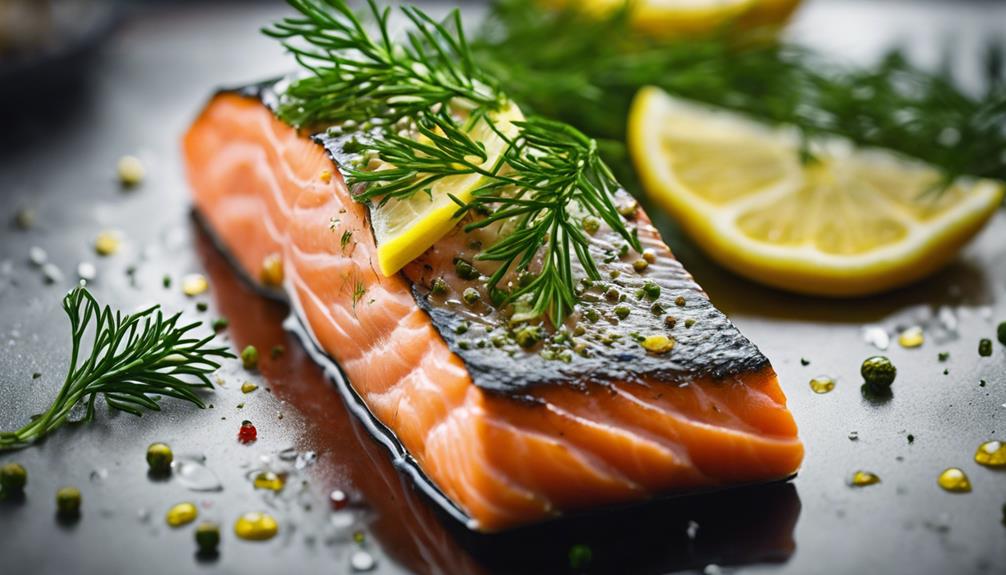
Consider reflecting on your experience with this Sous Vide Salmon With Dill recipe to fully appreciate the delicate flavors and textures achieved through this cooking method. By cooking the salmon at a precise temperature in a water bath, you likely noticed how the fish retained its moisture and tenderness while absorbing the aromatic dill-infused flavors. The slow, gentle cooking process allowed the salmon to reach the ideal doneness without any risk of overcooking, resulting in a velvety smooth texture that melts in your mouth.
As you savor each bite of the Sous Vide Salmon With Dill, you may have also appreciated how the dill added a subtle herbaceous note that complemented the natural richness of the fish without overpowering it. The simplicity of the ingredients and the precise cooking technique showcased the beauty of letting quality ingredients shine on their own.
Furthermore, this sous vide method not only enhances the taste and texture of the salmon but also offers a convenient way to prepare a restaurant-quality dish in the comfort of your own kitchen. The minimal hands-on time required and the consistent results make this recipe a great option for both busy weeknights and special occasions. So, next time you're craving a luxurious yet effortless meal, consider reaching for your sous vide machine and treating yourself to this delightful Sous Vide Salmon With Dill.
Frequently Asked Questions
Can I Use Frozen Salmon for Sous Vide Cooking?
Yes, you can use frozen salmon for sous vide cooking. Make sure to properly thaw it before cooking. This method allows for precise temperature control and results in moist, tender salmon that retains its natural flavors.
What Alternative Herbs Can I Use Instead of Dill?
You can substitute herbs like parsley, tarragon, chives, or cilantro for dill in your recipe. Experiment with different herbs to find your favorite flavor combination that complements the salmon perfectly in your dish.
Is It Safe to Reuse Sous Vide Bags for Salmon?
Yes, it's important to thoroughly clean and sanitize sous vide bags for salmon before reusing them. However, it's essential to inspect for any damages or wear and follow proper food safety guidelines to prevent contamination.
Can I Sous Vide Salmon if I Don't Have a Vacuum Sealer?
If you don't have a vacuum sealer, you can still sous vide salmon by using the water displacement method. Simply place the salmon in a ziplock bag, seal it most of the way, then submerge it to push out the air before sealing completely.
How Can I Prevent the Salmon From Becoming Overcooked in Sous Vide?
To prevent salmon from overcooking in sous vide, maintain the water temperature consistently, use a timer to monitor cooking time accurately, and avoid leaving the fish in the water bath for too long after it's done.
Conclusion
To sum up, sous vide salmon with dill is a delightful and flavorful dish that showcases the rich culinary traditions of Scandinavia.
By utilizing key ingredients like fresh salmon and aromatic dill, you can prepare a dish that's both easy to make and brimming with flavor.
Whether you're an experienced chef or just beginning in the kitchen, this sous vide salmon recipe is certain to tantalize your taste buds and leave you yearning for more.
Enjoy!
